Letters from Lodi
An insightful and objective look at viticulture and winemaking from the Lodi
Appellation and the growers and vintners behind these crafts. Told from the
perspective of multi-award winning wine journalist, Randy Caparoso.
Putting to bed the myth that light and crisply balanced whites can't be grown in warm climates
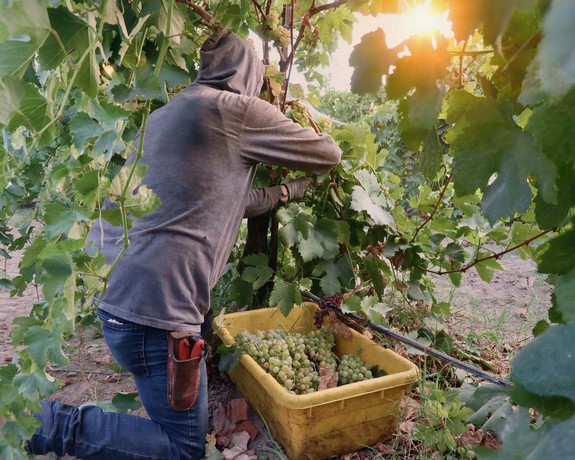
Clements Hills-Lodi harvesting of Assyrtiko, a Mediterranean grape of Greek origin known for retaining a refreshingly high acidity grown in even the hottest, dryest climate.
Albariño, Assyrtiko, Bacchus, Bourboulenc, Chenin blanc, Clairette blanche, Grenache blanc, Fiano, Kerner, Macabeo, Parellada, Piquepoul, Riesling, Vermentino, Xarel-lo and more...
The other day I was telling an old friend/colleague about a fantastic 20-year-old bottle of white wine grown in Lodi I recently enjoyed. How it tasted fresh as a daisy and, a little surprising, was made from Chardonnay⏤a grape not exactly considered the pièce de résistance of Lodi, a region better known as the "Zinfandel capital of the world."
He stopped me and said, "Wait a second... there is white wine in Lodi?" He wasn't being facetious.
Needless to say, I told my friend that Lodi is like any other commercial wine region, and any region that grows grapes for wineries that put the kazillion bottles of wine on grocery store shelves across the country has to grow white wine grapes, and lots of them.
After my conversation, I looked up the most recent California Grape Acreage Report (2023) and saw that 23.35% of the wine grapes grown in Lodi are for white wines. Less than I had thought (21,525 acres, to be exact), but still nothing to sneeze at.
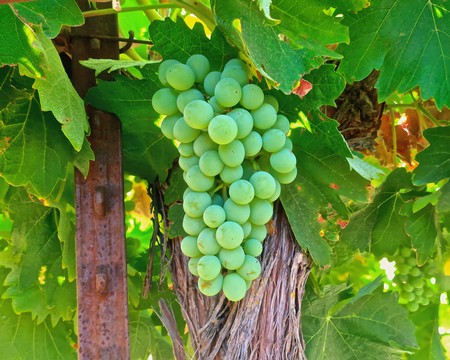
Vermentino, a Southern French white wine grape that thrives in Lodi's Mediterranean climate.
While sifting through the figures, I also saw that reported plantings of Zinfandel in Lodi are down to 14,632 acres. The report also shows there are 14,102 acres of Cabernet Sauvignon in Lodi. So while Cabernet Sauvignon plantings are catching up, Zinfandel still remains "king" in Lodi.
But I digress. The reason, no doubt, why many perfectly intelligent wine consumers are still surprised to learn that Lodi grows and produces white wines is because Lodi is a warm climate region, and top quality white wines are not usually associated with warm climate regions.
The official description of the climate found in Lodi is "Mediterranean," which ScienceDirect.com defines as "mild, wet winters, and warm to hot, dry summers, with three-fourths of the annual precipitation concentrated between late autumn and spring."
The Köppen climate classification identifies Mediteranean climate regions all around the world, from California to Chile, Australia to South Africa, and of course, in most of the countries ringing the Mediterranean Basin.
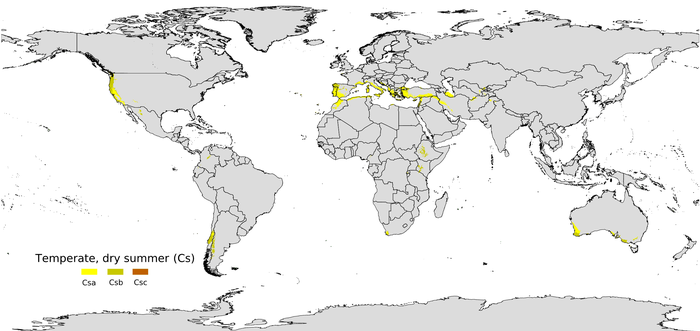
Kõppen-Geiger global map identifying regions with the two variants of Mediterranean climate: hot-summer Mediterranean climate (Csa) and warm-summer Mediterranean climate (Csb); Lodi falling under the Csa classification. Wiki Commons.
The ideal wine grapes for warm to hot climates are, indubitably, red wine grapes. Zinfandel, for one, originated in Croatia and has long been grown in Southern Italy—quintessential Mediterranean climate regions—which is undoubtedly the reason why, of all wine grapes first planted in California as experiments during the second half of the 1800s, Zinfandel was found to be the most ideally suited to the climate.
A common belief among wine buffs is that, because white wines depend on a good balance of natural acidity in order to retain a freshness of fruit profile, they have to be grown in cooler climate regions, and not in hot Mediterranean climates. Stands to reason. However, both Nature and humanity found ways around that supposition long ago.
During the past 2,000 or so years, white wine varieties with the ability to retain perfectly good acidity in even the hottest climate zones have been domesticated and proliferated throughout Mediterranean regions.
Greece, for one example, has come to be known for white wines made from Assyrtiko, a grape that retains extremely high acidity despite the searing hot summers of the Grecian islands.

Piquepoul harvest in Lodi's Mokelumne River Viticultural Area.
There is a white wine grape called Piquepoul, which translates as "lip stinger" in reference to its lemony acidity, long cultivated in a French region called Picpoul de Pinet, located on the southern coast next to Spain. In an inlet below Picpoul de Pinet you'll find hundreds of oyster beds; producing, of course, the bivalve that is at its best when soaked in tart lemon juice⏤or as the French would have it, washed down by bottles of lemony Picpoul de Pinet.
The list of high acid white wine grapes cultivated for centuries in the hottest winegrowing regions goes on and on. Because of Lodi's Mediterranean climate, it stands to reason that many of these grapes are now producing successful wines in Lodi. To wit...
Light, authentically "lip stinging" Piquepouls grown in Lodi are now bottled under brands such as Acquiesce, Lorenza, PRIE and Voluptuary. If anything, Lodi bottlings are even more lemony tart than those of France's Picpoul de Pinet (something confirmed in blind tasting after blind tasting).
Recently, Perlegos Family and Sandlands have come out with sensational Lodi-grown Assyrtikos, with all the lemony tartness, minerality and honeyed fruit fragrances associated with Assyrtikos from Greece, although without the super-high alcohol levels of typical Greek Assyrtikos.
Peltier Winery has long been growing amazing Vermentino, a grape originally associated with Provence, Corsica and Sardinia in the middle of the Mediterranean. Other Lodi-grown bottlings capturing the crisp, citrus/mineral qualities intrinsic to Vermentino include Avivo, Monte Rio and Pax.
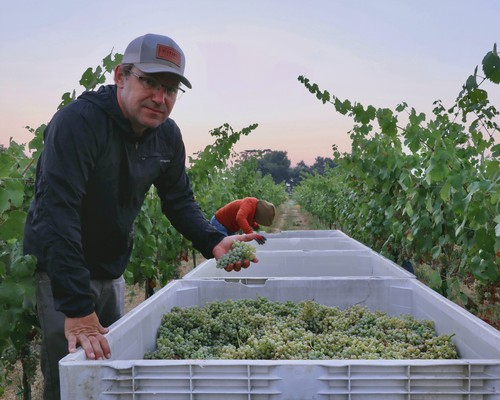
Chef Jake des Voignes harvesting Fiano, a grape native to Italy's Campania region, in his Fernow Ranch, on the east side of the Mokelumne River-Lodi AVA.
Acquiesce Winery also specializes in grapes such as Grenache blanc (a workhorse white wine grape throughout Southern France), Bourboulenc and Clairette blanche. The latter is used with the Marsanne grape to produce Provence's legendary Cassis, a seaside appellation known for whites of feathery light crispness, silkiness, minerality, and seamless suitability with seafoods of all sorts (can you say bouillabaisse?). In other words, acid-driven white wines.
Lodi's Oak Farm Vineyards grows and produces Fiano, an ancient grape of Campania in Italy known as much for its citrusy acidity as its anise-like scent.
Just this past week, Bokisch Vineyards bottled its first commercial varietal Xarel-lo, a high-acid, mineral-driven grape that originated long ago in Catalonia, located in the north-east corner of Spain known, of course, for its hot Mediterranean climate.
Probably without knowing it, longtime lovers of Spanish cava (i.e., sparkling wine) have always enjoyed wines made from Xarel-lo because it is one of the three major grapes (along with Macabeo and Parellada) that go into the making of this "Spanish champagne." Cava production demands high acid grapes. Unsurprisingly, Bokisch Vineyards also grows Macabeo and Parrellada.
And the list of these lighter, higher acid style white wines coming out of Lodi is growing with each passing vintage.

Xarel-lo,, a native Spanish cava grape, in Bokisch Vineyards' Miravet Vineyard, at the northern edge of Lodi's Clements Hills AVA.
The most incessant myth
The wine world is full of myths, or unfounded beliefs. The problem, of course, is that we are all only human, and humans live and die by their beliefs, whether they make sense or not.
One of the biggest myths endlessly repeated wherever wine information can be found is this: That warmer climate regions always produce heavier, riper wines with lower acidity, whereas cooler climate regions always produce lighter, finer wines with higher acidity.
There are two reasons why this assumption is very, very wrong:
1. There is an increasing number of wines grown in Lodi's warm climate that are the opposite of what is commonly assumed⏤lighter in weight and alcohol, emphatic in acidity, and with fruit profiles that are not only subtle in "ripeness" but also tinged with non-fruit (especially mineral or earthy) qualities.
2. California wine regions known for cooler climates than that of Lodi's, from Santa Barbara all the way up to Mendocino, can and often do produce fuller bodied wines with lower acidity, higher alcohol plus riper tannin and fruit flavors, not much different from what you expect out of Lodi.

Bare Ranch Chardonnay harvest—when grown in Lodi's Mokelumne River AVA, the grape typically produces a fragrant yet lighter, crisper style of the varietal.
How can this be so? Number one, as previously mentioned, is the factor of grape varieties. Certain varieties produce light and zesty wines, no matter how hot the climate.
Number two, though, is the simple fact that wines don't make themselves. While environmental factors such as climate and grapes determine how wines turn out, just as big are the decisions made by the growers and vintners themselves.
Therefore, a Pinot Noir producer in, say, Santa Barbara's Sta. Rita Hills or Sonoma's Russian River Valley may very well choose to pick grapes with high enough sugars to produce bigger styles of the varietal (over 14.0% alcohol) possessing ripe, opulent qualities; and, in fact, because these styles of Pinot Noir are very popular (and also garner high "scores"), many of California vintners are producing exactly this style of wine.
The same for other popular varietals, such as Chardonnay, Cabernet Sauvignon and Zinfandel: Some of the biggest, ripest, heaviest styles of these varietals come from regions that have demonstrably cooler climate growing seasons than Lodi. These are the choices made by winemakers and brands.
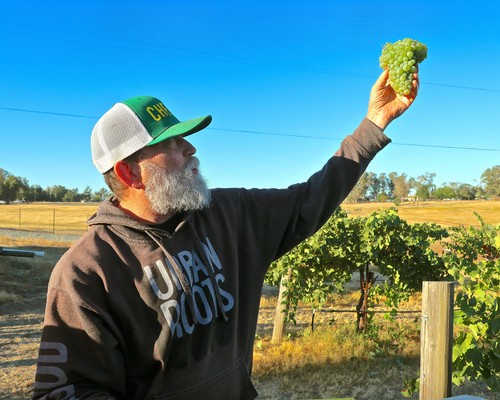
Haarmeyer Wine Cellars owner/winemaker Craig Haarmeyer during Chenin blanc harvest in Palmero Vineyard, Lodi's Alta Mesa AVA.
Just this past weekend, on the other hand, I had the opportunity to revisit a white wine crafted by a vaunted Lodi winemaker named Markus Niggli. The wine, Mr. Niggli's 2014 Markus Wine Co. Lodi Nativo (a blend of 75% Kerner with Riesling and Bacchus grapes), was over 10 years old but still tasting fresh as spring, light as air, crisp as a crunchy, just-plucked apple. Defying, on every level, all of the myths about Lodi as being too warm a region to produce anything but big, fat, heavy or overly fruited wines.
How has Niggli been able to do this, in every vintage since arriving in Lodi from his native Switzerland, some 18 years ago? First, because he can. That is, he is talented and wily enough to pick these grapes when they are still low enough in sugar and high enough in acidity to end up with a light, zesty wine that is as minerally as it is floral or fruity.
Second, it is because Lodi's terroir permits wines like Mr. Niggli's to be made. While the climate can be described as "hot," the region's growing seasons are marked by the exact same diurnal fluctuations (i.e., cool nights, warm days) typifying almost the entire California coast. Because of that, you can ripen grapes in Lodi that retain both acidity and freshness. This is also the key to producing wines that can age gracefully in the bottle for over 10 or even 20 years.
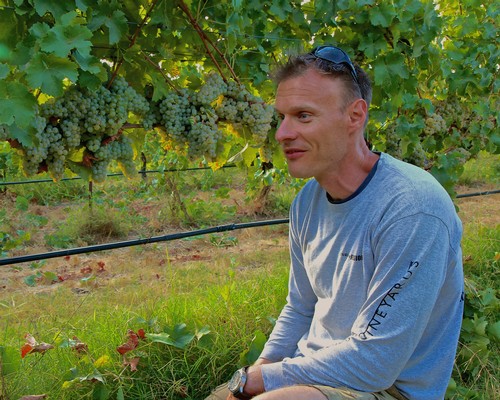
Markus Wine Co.'s Markus Niggli during Kerner harvest in Lodi's Mokelumne River AVA.
Niggli's Nativo, however, is not exactly an outlier, or rare freak of nature. There are, for instance, approximately a dozen and a half brands of Lodi-grown Albariño, a Spanish grape native to the north-east tip of Spain along the Atlantic coast, that taste just as light, zesty in acidity, fresh, floral and minerally as just about all the Albariños imported from Rías Baixas, considered one of Spain's cooler climate regions.
Lodi Albariños are comparable to any grown in the world for the exact same reasons why the Markus Wine Co. Nativo ages effortlessly in the bottle for over 10 years: Because Lodi winemakers are smart enough to make them that way, and because the Lodi terroir permits it.
Other handcraft producers are achieving similar results, employing guile as winemakers and savvy as grape sourcers. Craig Haarmeyer's Haarmeyer Wine Cellars Lodi Chenin Blanc, for instance, is always every bit as sharp in acidity, and as stony as well as flowery-fresh as any Chenin Blanc in California⏤and for that matter, as much as any Chenin blanc-based white coming from the grape's native habitat in the Loire River of France.
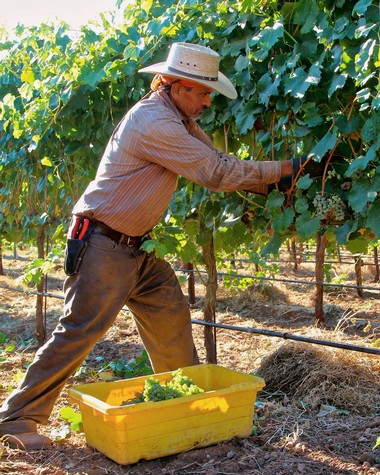
Albariño harvest in Lodi's Clements Hills appellation.
Speaking of "effortlessly": Acquiesce Winery owner/grower Sue Tipton has been doing the same with her portfolio of over a dozen varietal whites and blends over the past ten or so years. In blind tasting professional competitions, Acquiesce whites predictably clean up, garnering every "Best of Class" or "Best of Show" award there is to win. Not surprisingly, Tipton was named "Woman Winemaker of the Year" at the 2022 International Women's Wine Competition.
None of this happened because Acquiesce produces big, fat, heavy, overripe wines. It's because Acquiesce produces lithe and delicate, finely balanced and restrained wines reminiscent of (you got it!) wines grown in cool climate regions.
Point being, it is time to put these errant assumptions to bed. Yes, Lodi is known for red wines, but the exact same climate and soils furnish a natural proclivity to grow white wine grapes. And not just any white wine grapes. These are grapes that end up producing some of the finest white wines in California, the entire country, and which, time and time again, are demonstrably comparable to the finest in the world.
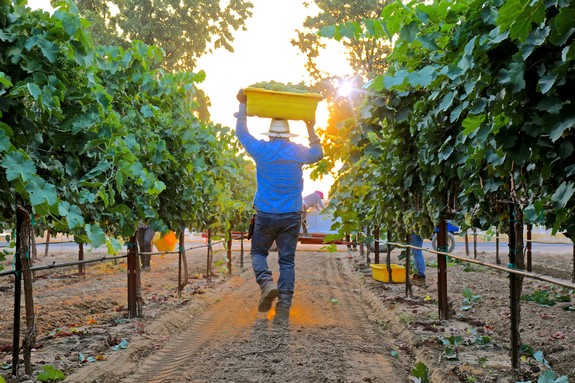
Clairette blanche harvest in Acquiesce Vineyard, a grape typically producing a zesty white wine with emphatic minerality in the Lodi appellation.